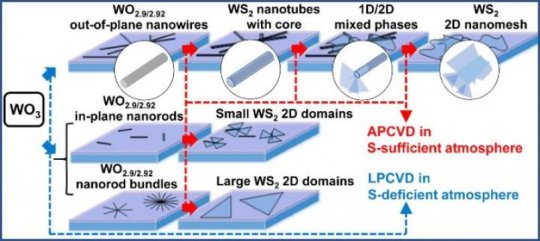[ad_1]
Physicists at the University of Bath have developed a flexible process allowing the synthesis in a single flow of a wide range of novel nanomaterials with various morphologies, with potential applications in areas including optics and sensors.
The nanomaterials are formed from Tungsten Disulphide — a Transition Metal Dichalcogenide (TMD) — and can be grown on insulating planar substrates without requiring a catalyst. TMDs are layered materials, and in their two-dimensional form can be considered the inorganic analogues of graphene.
The various Tungsten Disulphide morphologies synthesized — two-dimensional sheets growing parallel to the substrate, nanotubes, or a nanomesh resembling a ‘field of blades’ growing outwards from the substrate — are possible due to Dr. Zichen Liu’s PhD research at Bath to split the growth process into two distinct stages. Through this decoupling, the growth process could be routed differently than in more conventional approaches, and be guided to produce all these material morphologies.
So far, the ‘field of blades’ morphology has shown powerful optical properties, including strong non-linear effects such as Second Harmonic Generation, that is, doubling the frequency and halving the wavelength of laser light, changing its colour as it does so. The strength of these effects opens up a range of optical applications for the material.
The research is published in ACS Nano.
Dr Adelina Ilie, from the University of Bath’s Department of Physics, who led the research, said: “The simplicity of this process is important from the standpoint that it allows us to obtain practically all phases of this Transition Metal Dichalcogenide, from in-plane to out-of-plane, as well as from two-dimensional sheets to one-dimensional nanotubes and everything between. Usually different processes are used to create the two-dimensional or the one-dimensional morphologies. Our process, instead, leads to tunable materials with tunable properties.
“The ‘field of blades’ morphology is entirely new, and due to its very large effective surface area, might be of interest not only for the non-linear optical properties we showed so far, but also for application in various sensing technologies. We are exploring all these avenues now.”
Professor Ventsislav Valev, who tested the nanomesh for optical properties added: “We haven’t actually been able to test the upper limits of the optical effects yet because the signal is too strong for the equipment we used to probe it. We are talking about a material that is one or two atoms in thickness; it is quite extraordinary. Its arrangement into a ‘field of blades’ clearly increases the signal.”
The team plans to continue to explore the properties of the materials.
Story Source:
Materials provided by University of Bath. Note: Content may be edited for style and length.
[ad_2]















